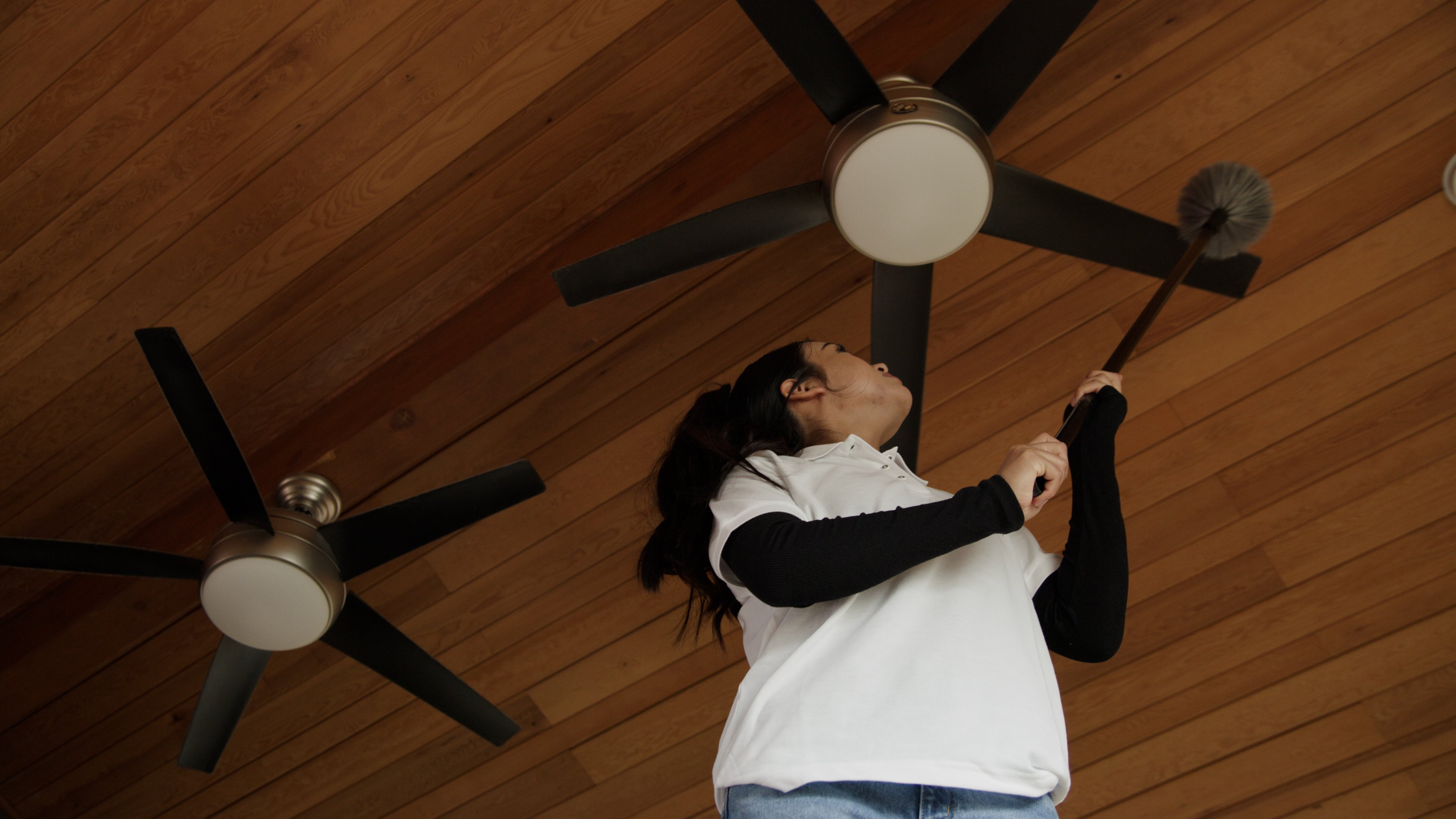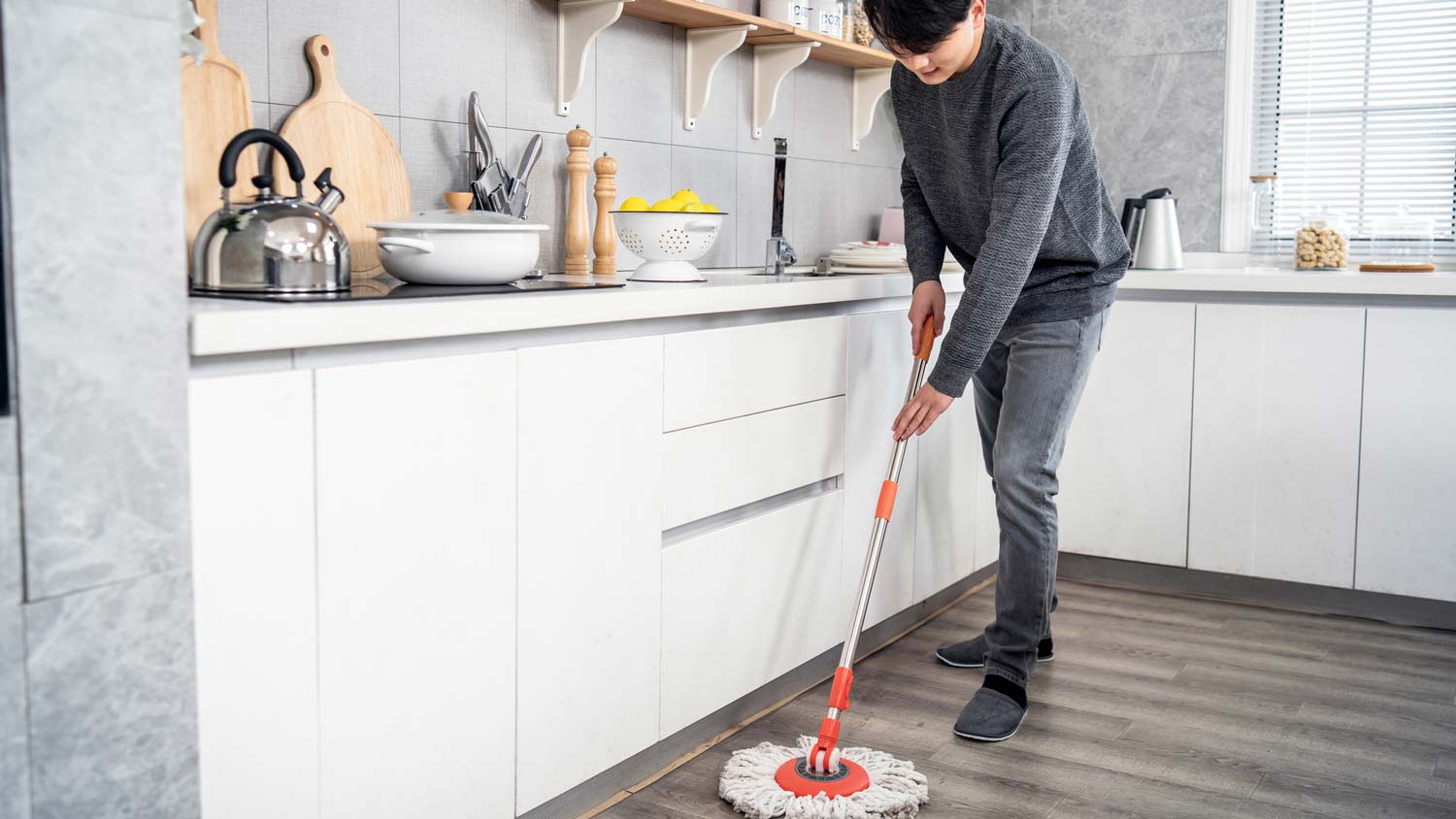How to Clean a Fan of Any Kind
Keep your fans looking fresh and clean


Fans are a household staple: They cool us off when our home feels stuffy or humid and double as high-functioning white noise machines for light sleepers. However, fans accumulate dust, dirt, cobwebs, and other grime while pulling in the air. Keeping your fans nice and clean is not only for aesthetics, as clogged-up blades lead to shorter life spans and decreased cooling power. Let’s review how to clean every fan in your house, including wiping down ceiling fans, tower fans, and everything in between.
How to Clean the Fans in Your Home

Here are some foolproof methods for cleaning your home’s various fans.
Pedestal Fans
Make sure the fan is powered off and unplugged before cleaning.
For a light touch-up, use a damp towel to wipe down the grates, blades, base, and the remaining exterior components.
Some designs require grate removal to access the oscillating blades. Follow the manufacturer’s instructions for this step.
For deeper cleaning, move the fan outdoors or an unused part of the home. This step prevents the scattering of dust in a highly-trafficked area.
Take the fan apart with a screwdriver.
Fill a sink or large bucket with warm water and a small amount of dishwashing liquid.
Place the nut, blades, and grill portions into soapy water. Wash each component by hand, allowing them to dry for at least 15 minutes.
Use a can of compressed air or a dry microfiber cloth to clear away any dust on or around the motor enclosure.
Rebuild the fan and reinstall it.
Tower Fans
Unplug the unit and power it down before cleaning.
Use a vacuum with a brush attachment to suck up dust from the vents. Finish it off by wiping the exterior down with a dry microfiber cloth.
For a deeper cleaning, remove the screws that hold the casing to the fan’s frame. Keep the screws handy for rebuilding.
Gently pry the casing from the top using a flathead screwdriver. Work your way down but don’t use too much pressure here to avoid damage.
Lay the fan down on an even surface and use a can of compressed air to loosen and remove debris from the blades and nearby components.
Vacuum the fan blades with the brush attachment, going down the length of the cylinder.
Vacuum the casing behind the blades, the motor, and the various brackets.
Reattach the casing and put the screws back in.
Window Fans
Unplug the fan and power it down.
Removing the fan from the window is unnecessary for touch-up cleaning. Use a damp cloth and wipe down any easily accessible components. Allow the fan to dry for 30 minutes before plugging it back in.
For a deep cleaning, remove the fan from the window. This process differs depending on the fan’s design. You can pull some fans out by hand while others require removing some screws.
Place the fan face-up on a towel or a plastic-covered work surface. Think about moving it to the garage, kitchen, or outdoors.
Remove the screws around the perimeter of the casing with a screwdriver. Then, separate the grill cover from the back of the fan.
Use a paper towel to remove any collections of loose matter from the various components, such as pet hair or lint buildup.
Fill a bucket with hot water and a mild cleaning liquid. Dip a sponge or rag into the solution, squeeze it out, and wipe down the parts inside and out. These include the blades, the great, the front panel, and various knobs. Use a brush to scrub down the holes in the grill grate.
Repeat the process with a new sponge or rag.
Let the fan dry for 30 minutes before reassembling it and placing it back into the window frame.
Ceiling Fans

Power it down before cleaning, including shutting off power from the junction box. Ensure there’s another person on-hand to keep you steady as you climb the ladder.
For a touch-up, grab a damp cloth and wipe down the blades. Another option is to use a dedicated ceiling fan cleaning tool with a telescoping pole.
For a deeper clean, open the compartment surrounding the motor by hand or with a screwdriver, depending on your fan’s design.
Use canned air to spray the motor to remove dust and dirt. Close the compartment back up.
Next, work on the blades. Wipe each blade with a dry microfiber cloth to remove large dust accumulations.
Apply a mild cleaning solution to a dry rag and scrub each blade vigorously to finish the job. Repeat the scrubbing process if needed.
Wipe down light fixtures with a dry microfiber cloth and change out any dim light bulbs.
Wipe down the area underneath the ceiling fan, including tables and chairs.
Bladeless Fans
Unplug the fan and power it down. Use a moist cloth and gently rub down the circular surface of the fan.
For a deeper cleaning, rub down the circular surface and then move on to oft-neglected components.
Grab a vacuum with a brush extension. Locate the back vents, usually housed within circular grooves, and remove dust from these vents using the vacuum.
Clean the remaining components with a paper towel and let the fan dry before powering it back on.
Whole-House Fans
Turn off the power to prevent electrical risks to the home and to yourself.
Spray a mild household cleaner onto a microfiber cloth.
Wipe off the dust and debris off the blades. Avoid spraying directly onto the motor.
Use a slightly damp microfiber cloth to clean the motor.
Brush and vacuum the louvers.
Exhaust Fans
Turn off the power to the fan, as well as the circuit at the breaker box, to be extra safe.
Use a microfiber cloth to wipe away the dust.
If you can remove the vent cover and there’s no light attached to it, submerge the cover in a sink full of soapy water. Scrub the vents with an old toothbrush to remove the dust and debris. Let it air-dry completely.
Use a microfiber cloth to wipe the blades and other non-electric parts.
To clean the motor, unplug the connector and unscrew it from the housing component.
Vacuum away the debris with a hose attachment or use compressed canned air to blow away caked-on dirt.
Reassemble the motor, and screw the vent cover back on.
Tips for Keeping Your Fans Clean of Dust
Now that you’ve deep-cleaned every fan in your house, perform weekly touch-ups to keep them in pristine condition. There are some other ways, however, to ensure your fans avoid buildups of grime.
Dust the fan blades regularly.
Consider placing air purifiers throughout the home to pick up floating dust particles.
Vacuum and clean the rest of the home regularly, limiting the amount of dust.
Use a commercial anti-static, dust-repellent spray on large ceiling fan blades.
Why Do I Need to Clean My Fans?
It’s easy to overlook fans during your regular house cleanings. They are oddly shaped and feature many dusty components that are difficult to reach. However, keeping your fans clean is extremely important for several reasons.
Dirty fans blow dirty air: Unless you want to spend your entire paycheck on air purifiers, keep the fans clean to avoid spreading dusty air throughout the home.
Clean fans work more efficiently: Clean your fans to experience optimal performance, and bask in the best breeze possible.
Increases its life span: Most fans last around 10,000 hours of continuous use, but this metric decreases if the fan is dirty.
Dirty fans are unappealing: If your fans are covered in cobwebs and dust, polish them up to add more shine to your personal space.
Dust is more than just a nuisance. According to the American Lung Association, dust can cause allergy and asthma symptoms. Dust regularly to keep your home and family healthy.
How Much Does It Cost to Professionally Clean Your Fans?
Professional house cleaners near you have experience with the vast array of designs that comprise modern house fans. Hiring a local cleaning service costs around $30 to $50 per hour, and they come equipped with the various tools needed to give your fans a thorough cleaning. When hiring a house cleaning service, specify what types of fans you’d like them to clean during their visit.
DIY vs. Hiring a Pro to Clean a Fan

Cleaning fans is a DIY-friendly task, but it quickly becomes overwhelming if you haven’t cleaned your fans in a while. Consider hiring a professional house cleaner if you have multiple ceiling fans in various rooms, saving yourself the frustration and risk of repeatedly climbing up and down a ladder. If you only have a few fans and most of them are on the smaller side, you can likely tackle this cleaning task within a few hours.
Frequently Asked Questions
As a general rule of thumb, clean your fans whenever you tidy up the home. Fans benefit greatly from a light weekly cleaning and a deep cleaning at the start of each season. If it’s been a while since you touched up the fans with oscillating blades, start with the deep cleaning before moving on to the lighter touch-ups. If you’re unsure when to clean fans and other parts of the home, learn how often you should clean your home.
Yes, dust and pollen on a fan can trigger allergy attacks in many people. Additionally, fan blades can hold onto potentially dangerous bacteria particles before they die out.
You can easily clean an electric fan by wiping it with a damp cloth, all-purpose cleaner, or mild detergent. Ensure the fan is not plugged in or turned on while you’re cleaning it. Also, try to keep liquids out of the motor, which can lead to damage.
Keeping dust off fans can keep them working optimally and help keep dust mites or bacteria from building up. Dust fans weekly with a duster, microfiber cloth, old pillowcase, or vacuum attachment. You can also try spraying a clean fan with a store-bought dust-repellent product or making a DIY dust-repellent with water and a small amount of liquid fabric softener mixed in.





- House Cleaning Services
- Housekeeping Services
- Tile Grout Cleaners
- Move Out Cleaners
- Deck Cleaning Services
- Same Day House Cleaning
- Ultrasonic Cleaning
- Apartment Cleaners
- Vinyl Siding Cleaning
- Mattress Cleaners
- Kitchen Hood Cleaning
- Emergency Cleaning Services
- Housekeeper Agencies
- Residential Cleaners
- Cleaning Crews
- Couch Cleaning
- Garage Cleaning Services
- Odor Removal Services
- Commercial Cleaning Services
- Should You Install a Fan or an Air Conditioner? Here’s How to Decide
- How Do Ceiling Fans Work? Pros, Cons, and Cooling Hacks
- 7 ‘Cool’ Tips for Keeping Rooms Cool With Fans
- Do Ductless Bathroom Fans Remove Moisture?
- What Is an Exhaust Fan? Here's Everything You Need to Know
- Your Guide to the Best Types of Roof Vents to Keep Your Home Dry
- 10 Genius Fan Hacks to Keep Cool Even Without AC
- 9 Summer HVAC Tips to Stay Cool and Save Money
- Can a Whole-House Fan Keep Your Family Cool in Humid Climates?
- 9 Energy-Efficient Ways to Cool a Home











